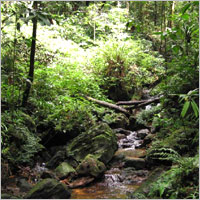Sinharaja,( the virgin rainforest of Sri Lanka):

Sinharaja Forest
Reserve of Sri Lanka is one of the virgin tropical rainforest of the world.
It is a paradise for wildlife species as well as nature lovers as it is a
living heritage. The Sinharaja region has long featured in the legends and
lore of the people of Sri Lanka. Its name, literally mean to lion (sinha)
king (raja), perhaps refers to the original 'king-sized or royal forest of
the Sinhalese', a people of the legendary 'lion-race' of Sri Lanka, or to
the home of a legendary lion of Sri Lanka. Bio diversity of the forest is
very high and a large proportion of the flora (60%) in this forest is
endemic and rare to the country and some endemic to the Singharaja Forest
itself. There is much endemic wildlife, especially birds, but the reserve is
also home to over 50% of Sri Lanka's endemic species of mammals and
butterflies, as well as many kinds of insects, reptiles and rare amphibians.
Geographical Location : Sinharaja Rainforest of Sri Lanka is located
in the south-west lowland wet zone within Sabaragamuwa and Southern
provinces. From the north it is bounded by the Napola Dola and Koskulana
Ganga, on the south and south-west by the Maha Dola and Gin Ganga, on the
west by the Kalukandawa Ela and Kudawa Ganga and on the east by an ancient
footpath near Beverley Tea Estate and by the Denuwa Kanda.
Area : This forest stretches to an area of about 18,899 hectares
from east to west .The length of the forest is about 21km and width from
North to South is about 3.7km.
Date and History Of Establishment:
Most of the area was originally
declared as a forest reserve on 3rd May 1875 under the Waste Lands Ordinance
and notified in the Ceylon Government Gazette No. 4046, dated 8 May 1875,
while the rest was notified a proposed forest reserve in the early 20th
century. Sinharaja Forest Reserve, comprising the existing and proposed
forest reserves, was declared a Man and biosphere (MAB) reserve in April
1978 and included in the list of Natural World Heritage Sites in 1989.
Flora of Sinharaja Forest:
Trees and plants found in Sinharaja
forest are high species endemism. Over 60% of countries endemic plant
species can be found within the boundaries of Sinharaja. The forest is multi
layered which is a characteristic to the rainforest and Mesua – Shorea
community and Dipteracarpus community, dominates the vegetation.
Large varieties of wild orchids, epiphytes and lianas can also be seen in
this forest. . Insect eating Pitcher plant is frequently seen here.The
largest known tree of the country is found in the Sinharaja, which is an
endemic tree.
Fauna of Sinharaja Forest:
Out of 12 endemic mammal species of the
country 8 are found here. Sinharaja Forest is inhabited by water monitors,
torque macaques, leopards, giant squirrels, dusky-stripped jungle squirrel,
and purple-faced leaf monkeys.
Almost 95% of the countries endemic birds (about 19 species) are found here.
Bird life includes Ceylon Spurfowl, Ceylon Junglefowl, Ceylon Wood Pigeon,
Sri Lanka Hanging Parrot, Layard's Parakeet, Red-faced Malkoha, Green-billed
Coucal, Chestnut-backed Owlet, Ceylon Grey Hornbill, Yellow-fronted Barbet,
Ceylon Small Barbet, Black-capped Bulbul, Spotted-winged Thrush,
Brown-capped Babbler, Orange-billed Babbler, Ashy-headed Laughing-Thrush,
Ceylon Blue Magpie, Ceylon White-headed Starling, Ceylon Hill Munia, Ceylon
Hill Myna, Malabar Trogon, Black Bulbul, Indian Scimitar Babbler, Greater
Racket-tailed Drongo, Green Imperial Pigeon, Velvet-fronted Nuthatch and
Yellow-browned Bulbul.
Diversity among the reptiles and Amphibians are remarkably high. The endemic
green pit viper, endemic hump nosed lizard (Lyriocephalus scutatus) and
horned lizard (Ceratophora aspera) are common here. Small tributaries and
rivers of the forest support the fish such as striped rasbora, walking
catfish and endemic comb tail. This magnificent rainforest is also a home
for large number of butterflies. Even the small streams found within the
forest are home to fish, toads and crabs.




 Sinharaja Forest
Reserve of Sri Lanka is one of the virgin tropical rainforest of the world.
It is a paradise for wildlife species as well as nature lovers as it is a
living heritage. The Sinharaja region has long featured in the legends and
lore of the people of Sri Lanka. Its name, literally mean to lion (sinha)
king (raja), perhaps refers to the original 'king-sized or royal forest of
the Sinhalese', a people of the legendary 'lion-race' of Sri Lanka, or to
the home of a legendary lion of Sri Lanka. Bio diversity of the forest is
very high and a large proportion of the flora (60%) in this forest is
endemic and rare to the country and some endemic to the Singharaja Forest
itself. There is much endemic wildlife, especially birds, but the reserve is
also home to over 50% of Sri Lanka's endemic species of mammals and
butterflies, as well as many kinds of insects, reptiles and rare amphibians.
Sinharaja Forest
Reserve of Sri Lanka is one of the virgin tropical rainforest of the world.
It is a paradise for wildlife species as well as nature lovers as it is a
living heritage. The Sinharaja region has long featured in the legends and
lore of the people of Sri Lanka. Its name, literally mean to lion (sinha)
king (raja), perhaps refers to the original 'king-sized or royal forest of
the Sinhalese', a people of the legendary 'lion-race' of Sri Lanka, or to
the home of a legendary lion of Sri Lanka. Bio diversity of the forest is
very high and a large proportion of the flora (60%) in this forest is
endemic and rare to the country and some endemic to the Singharaja Forest
itself. There is much endemic wildlife, especially birds, but the reserve is
also home to over 50% of Sri Lanka's endemic species of mammals and
butterflies, as well as many kinds of insects, reptiles and rare amphibians.![]()
![]()
![]()
![]()